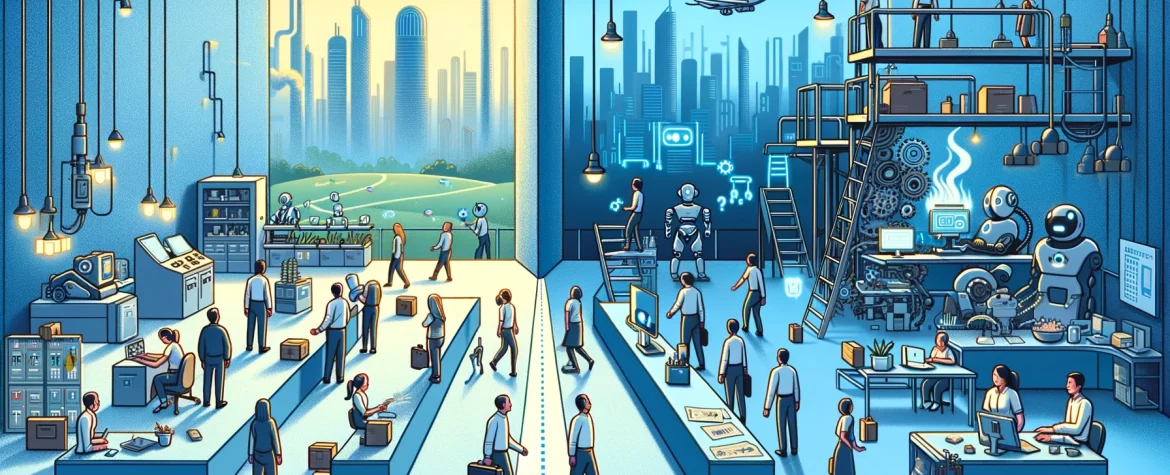The Tipping Point of Technological Unemployment: Preparing for the Inevitable Shift
- Home
- The Tipping Point of Technological Unemployment: Preparing for the Inevitable Shift

- Deeksha Joshi
- March 1, 2024
- 0 Comments
As the winds of change sweep across the global economic landscape, the sails of the workforce are feeling the gusts of technological advancement like never before. The pace at which automation and artificial intelligence (AI) are evolving presents not only a groundbreaking shift in how we conduct business but also a monumental challenge in the realm of employment. As a Female Leader and Technology Ethicist at No Worker Left Behind, I stand at the crossroads of innovation and human capital, contemplating the profound impact of technological unemployment. Here, let us venture into the critical role of corporate executives in this era of transformation and explore actionable insights crucial for steering the future of work towards a horizon of inclusive growth.
First, it is imperative for executives to develop a keen sense of foresight regarding the flux of skill sets in the marketplace. By closely monitoring technological trends and analyzing the historical patterns of industry shifts, they can anticipate the abilities that will become obsolete and those that will rise in demand. To do this effectively, they must leverage data analytics and engage with thought leaders and innovators who shape the trajectory of their respective fields.
Secondly, strategic investments in re-skilling and up-skilling initiatives are essential for workforce relevance and competitiveness. Companies should channel resources into learning platforms that offer tailored, flexible, and accessible programs, ensuring that employees can swiftly adapt to new technologies. Moreover, fostering partnerships with online education providers can democratize learning opportunities, catering to diverse learning styles and schedules.
The cultivation of a continuous learning culture within organizations is paramount. Encouraging curiosity, promoting cross-disciplinary knowledge exchange, and rewarding skill acquisition can all contribute to a resilient and agile workforce. Leaders must champion this mindset by setting an example and recognizing the employees who undertake personal and professional development initiatives.
Furthermore, the collaborative efforts between corporations, educational institutions, governments, and non-profits can create a safety net for those most affected by technological shifts. Establishing apprenticeship programs, offering career transition services, and contributing to societal dialogues about future work structures are ways in which companies can play their part in a broader support ecosystem.
The ethical imperative for corporations is clear: they must act as stewards of the workforce, ensuring that technological progress does not exacerbate inequality or erode communal structures. This responsibility extends to the deployment of AI and automation in ways that augment human capabilities rather than replace them wholesale.
Scenario planning and future-proofing strategies are critical tools in a leader’s arsenal to counter technological unemployment. By envisioning various future states of the job market, companies can build contingency plans and cultivate a workforce equipped to thrive in multiple potential scenarios. Additionally, safeguarding the most vulnerable workers requires not only training but also policies that promote job security and fair compensation.
In the realm of job creation, the focus should shift towards nurturing roles that leverage human strengths such as creativity, empathy, and strategic thinking. As new technologies are adopted, companies should prioritize the development of complementary industries and services that can absorb the workforce displaced from traditional roles.
Lastly, corporate social responsibility (CSR) should extend to proactively addressing the challenges of technological unemployment. Through CSR, companies can invest in community-based workforce initiatives, support academic research on the future of work, and advocate for policies that promote a sustainable and equitable job market.
As we stand on the precipice of a dramatic shift in the workforce landscape, it is our collective responsibility as corporate leaders to ensure that no worker is left behind. The future of work is not a distant thought—it is an unfolding reality that demands our immediate and unwavering commitment.
In conclusion, the path to navigating the complexities of a technologically driven job market is multifaceted. It is a path that requires vision, ethical governance, and a steadfast dedication to the principles of inclusion and lifelong learning. Together, we can transform the tipping point of technological unemployment into a gateway for new opportunities, ensuring a prosperous future for all workers in the digital age.
